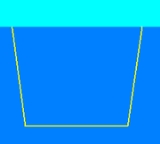
Dive profile
Encyclopedia
A dive profile is a two dimensional graphical representation of a dive showing depth and time.
It is useful as an indication of the risks of decompression sickness
and oxygen toxicity
and also the volume of open-circuit breathing gas
needed for a planned dive as these depend in part upon the depth and duration of the dive. A dive profile diagram is often drawn with time running from left to right and depth increasing down the page.

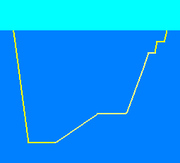

and a slow ascent rate to avoid decompression sickness.
This type of profile is common for dives at sites where there is a flat sea-bed. It is the most demanding profile for decompression for a given maximum depth and time because absorption continues at maximum rate for most of the dive. Decompression tables assume the diver has done a square profile.
permit, divers often prefer to do a more triangular than square dive profile; they descend to maximum depth and slowly ascend throughout the dive.
A slow ascent, and therefore slow pressure reduction, is a good decompression practice. When using a dive computer
this type of profile often results in no need for deliberate decompression stops. Dive computers, unlike decompression tables, measure depth and time at short intervals and calculate the exact decompression stops required, which for a triangular profile will be less than the square profile with the same maximum depth and duration.
At the surface the absorbed inert gases from the dive are eliminated as time passes. When completely "desaturated" the levels of those gases in the diver's body have returned to those normal at atmospheric pressure. The interval to complete desaturation varies depending upon factors such as the depth and duration of the dive, the altitude of the dive, the gas mixtures breathed on the dive, and the decompression strategy used. The maximum interval until desaturation on the BSAC 88 dive table is 16 hours.
Multiple decompressions per day over multiple days can increase the risk of decompression sickness because of the build up of asymptomatic bubbles, which reduce the rate of off-gassing and are not accounted for in most decompression algorithms.

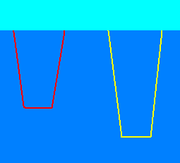
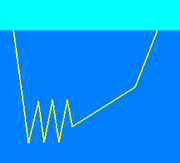
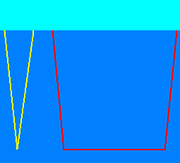
. Stops when breathing gas
es containing nitrogen tend to be in shallow water, usually in 3 metres (9.8 ft) steps. Stops when breathing helium mixes tend to be in deeper water. The duration of the shallower stops is more than the duration of deeper stops. Stops tend to make a dive profile triangular.
workshop concluded there was no reason for the diving communities to prohibit reverse dive profiles for no-decompression dives less than 40 metres (131.2 ft) deep and depth differentials less than 12 metres (39.4 ft).
where the diver lives at pressure for very long periods before ascending.
, while diver is on the surface, are drawn on a dive profile. The changes may be caused by flying, land travel involving changes in altitude, or atmospheric pressure changes due to weather. Ambient pressure changes before and after diving can be significant in decompression planning. Starting dives at altitude
also has an impact on dive and decompression planning.
It is useful as an indication of the risks of decompression sickness
Decompression sickness
Decompression sickness describes a condition arising from dissolved gases coming out of solution into bubbles inside the body on depressurization...
and oxygen toxicity
Oxygen toxicity
Oxygen toxicity is a condition resulting from the harmful effects of breathing molecular oxygen at elevated partial pressures. It is also known as oxygen toxicity syndrome, oxygen intoxication, and oxygen poisoning...
and also the volume of open-circuit breathing gas
Breathing gas
Breathing gas is a mixture of gaseous chemical elements and compounds used for respiration.Air is the most common and only natural breathing gas...
needed for a planned dive as these depend in part upon the depth and duration of the dive. A dive profile diagram is often drawn with time running from left to right and depth increasing down the page.
Planning and monitoring decompression
For planning and monitoring of nitrogen absorption, the data usually consists of the maximum depth reached during the dive and the length of time underwater. For repetitive dives it also includes the "surface interval", or the time spent above the water between the previous dive and the start of the current dive. This information is used to calculate the amount of residual nitrogen build-up in the diver's tissues after completing a dive.Types of dive profile
Some types of dive profile have been named.


Square profile
The diver descends directly to maximum depth, spends most of the dive at maximum depth and then ascends directly at a safe rate. The sides of the "square" are not truly vertical due to the need for a slow descent to avoid barotraumaBarotrauma
Barotrauma is physical damage to body tissues caused by a difference in pressure between an air space inside or beside the body and the surrounding fluid...
and a slow ascent rate to avoid decompression sickness.
This type of profile is common for dives at sites where there is a flat sea-bed. It is the most demanding profile for decompression for a given maximum depth and time because absorption continues at maximum rate for most of the dive. Decompression tables assume the diver has done a square profile.
Multi-level diving
Where the dive site and underwater topographyTopography
Topography is the study of Earth's surface shape and features or those ofplanets, moons, and asteroids...
permit, divers often prefer to do a more triangular than square dive profile; they descend to maximum depth and slowly ascend throughout the dive.
A slow ascent, and therefore slow pressure reduction, is a good decompression practice. When using a dive computer
Dive computer
A dive computer or decompression meter is a device used by a scuba diver to measure the time and depth of a dive so that a safe ascent profile can be calculated and displayed so that the diver can avoid decompression sickness.- Purpose :...
this type of profile often results in no need for deliberate decompression stops. Dive computers, unlike decompression tables, measure depth and time at short intervals and calculate the exact decompression stops required, which for a triangular profile will be less than the square profile with the same maximum depth and duration.
Repetitive diving
Repetitive diving occurs when two dives are separated by a short surface interval, during which the diver has not completely desaturated from the first dive. The gas loading from the first dive must then be taken into account when determining no stop times and decompression requirements for the second dive.At the surface the absorbed inert gases from the dive are eliminated as time passes. When completely "desaturated" the levels of those gases in the diver's body have returned to those normal at atmospheric pressure. The interval to complete desaturation varies depending upon factors such as the depth and duration of the dive, the altitude of the dive, the gas mixtures breathed on the dive, and the decompression strategy used. The maximum interval until desaturation on the BSAC 88 dive table is 16 hours.
Multiple decompressions per day over multiple days can increase the risk of decompression sickness because of the build up of asymptomatic bubbles, which reduce the rate of off-gassing and are not accounted for in most decompression algorithms.




Decompression profile
When no stop depth or time limits are exceeded the diver must do decompression stops to reduce the risk of decompression sicknessDecompression sickness
Decompression sickness describes a condition arising from dissolved gases coming out of solution into bubbles inside the body on depressurization...
. Stops when breathing gas
Breathing gas
Breathing gas is a mixture of gaseous chemical elements and compounds used for respiration.Air is the most common and only natural breathing gas...
es containing nitrogen tend to be in shallow water, usually in 3 metres (9.8 ft) steps. Stops when breathing helium mixes tend to be in deeper water. The duration of the shallower stops is more than the duration of deeper stops. Stops tend to make a dive profile triangular.
Reverse profile
Reverse profiles occur when a repeat dive is deeper than the earlier dive. Many diver training agencies discourage reverse profiles because they are not the best way to plan for safe decompression; it is better to do the deeper dive first when the body's tissues hold less absorbed nitrogen. The American Academy of Underwater SciencesAmerican Academy of Underwater Sciences
The American Academy of Underwater Sciences is a group of Scientific organizations and individual members who conduct scientific and educational activities underwater...
workshop concluded there was no reason for the diving communities to prohibit reverse dive profiles for no-decompression dives less than 40 metres (131.2 ft) deep and depth differentials less than 12 metres (39.4 ft).
Saw tooth profile
In a saw tooth profile the diver ascends and descends a number of times during the dive. Each ascent and descent increases the risk of decompression sickness.Bounce profile
With a bounce dive the diver descends directly to the maximum depth, spends very little time at maximum depth and ascends directly at a safe rate to the surface. Bounce dives are often described in professional diving as the opposite to saturation divesSaturation diving
Saturation diving is a diving technique that allows divers to reduce the risk of decompression sickness when they work at great depth for long periods of time....
where the diver lives at pressure for very long periods before ascending.
Ambient pressure on the surface
Sometimes changes in ambient pressureAmbient pressure
The ambient pressure on an object is the pressure of the surrounding medium, such as a gas or liquid, which comes into contact with the object....
, while diver is on the surface, are drawn on a dive profile. The changes may be caused by flying, land travel involving changes in altitude, or atmospheric pressure changes due to weather. Ambient pressure changes before and after diving can be significant in decompression planning. Starting dives at altitude
Altitude diving
Altitude diving is scuba diving where the surface is 300 meters or more above sea level . The U.S. Navy tables recommend that no alteration be made for dives at altitudes lower than 91 meters and dives between 91 meters and 300 meters correction is required for dives over 44 meters sea water...
also has an impact on dive and decompression planning.

